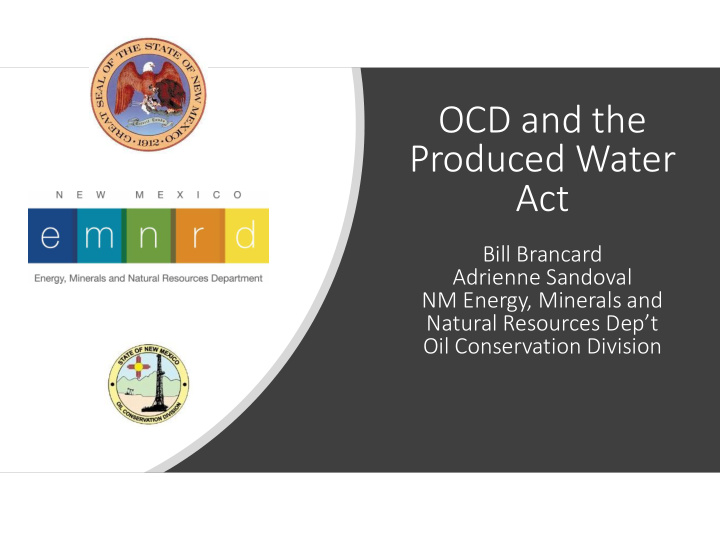



OCD and the Produced Water Act Bill Brancard Adrienne Sandoval NM Energy, Minerals and Natural Resources Dep’t Oil Conservation Division
New Mexico Oil il & Gas Regulation • Oil & Gas Act, NMSA 1978, Sections 70-2-1 et seq. (1935) • Oil Conservation Commission • Oil Conservation Division • Water Quality Act, NMSA 1978, Sections 74-6-1 et seq. • Constituent agency: NMSA 1978, Sections 74-6-2.K, 74-6-4.F • Water Quality Act exemption: NMSA 1978, Section 74-6-12.G • Safe Drinking Water Act primacy, 42 U.S.C. 300h-1; 40 CFR 147 • Class II: OCD – Oil and Gas Act • Class I, III, V: NMED or OCD – Water Quality Act 2
Key Changes in Produced Water Act HB 546 (which includes PWA): Clarifies administrative authority over the reuse of produced water: OCD limited to reuse within oil and gas industry NMED to regulate all uses outside of oil and gas industry Allows OCD to issue administrative penalties for violations of Oil and Gas Act and regulations (as of January 1, 2020) 3
PWA: Change to Oil il & Gas Act: 70-2-12(B)(15) • (15) to regulate the disposition of water produced or used in connection with the drilling for or producing of oil or gas or both and to direct surface or subsurface disposal of the water, including disposition by use in drilling for or production of oil or gas, in road construction or maintenance or other construction, in the generation of electricity or in other industrial processes, in a manner that will afford reasonable protection against contamination of fresh water supplies designated by the state engineer; • (15) to regulate the disposition, handling, transport, storage, recycling, treatment and disposal of produced water during, or for reuse in, the exploration, drilling, production, treatment or refinement of oil or gas, including disposal by injection pursuant to authority delegated under the federal Safe Drinking Water Act, in a manner that protects public health, the environment and fresh water resources; 4
Oil Production 5
Oil Production and Produced Water For every barrel of oil produced, about 4 barrels of produced water are generated. In 2019, New Mexico produced: • 324 million barrels of oil and • 1.253 billion barrels of produced water In 2016, New Mexico produced: • 146 million barrels of oil and • 856 million barrels of produced water New Mexico is now third amongst the states in oil production behind only Texas and North Dakota. Five years ago, New Mexico was sixth and has since surpassed the states of California, Oklahoma, and Alaska. 26,183 active oil production wells statewide. 6
Produced Water Estimates of produced water disposition: • 60% disposed in deep injection wells • 30% used in enhanced oil recovery • 10% recycled in oil drilling There are presently 828 active disposal wells in New Mexico with the vast majority situated within the Permian Basin (716). Another 127 disposal wells have been approved by the Division but are not yet drilled. There are 3,096 active EOR wells statewide with all but 33 of those wells in the Permian Basin. 7
Disposal Well Applications per Quarter 8
Current Produced Water Recycling Rules State seeks to encourage reuse and recycling of water • “Pit rule” establishes specific standards for siting, permitting, design, operation and closure of impoundments. 19.15.17 NMAC • New category of impoundments can be used by multiple wells • Revised produced water rule allows for easier approval of facilities that are to be used exclusively for recycling produced water. 19.15.34 NMAC • Recycling facilities must be registered with the OCD and comply with criteria for siting, construction, operation, maintenance, throughput reporting, closure, and financial assurance. • There have been 144 such facilities registered with the OCD, with 95 of them situated in the Permian Basin. 9
Produced Water Act Implementation Energy, Minerals and Natural Resources Department will: Implement administrative penalty authority created in HB 546 ◼ Penalty authority became effective January 2020 ◼ Rulemaking to implement administrative enforcement process completed in February 2020 Clarify produced water jurisdiction between EMNRD and NMED ◼ Minor changes to oil and gas rules anticipated Further encourage use of recycled produced water in oil and gas activities ◼ Existing rules encourage recycling of produced water ◼ Investigate policy and rule changes to further encourage recycling 10
Recommend
More recommend